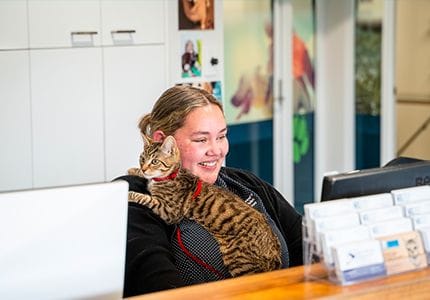Dr Chris Halman BVSc MANZCVS Small Animal Medicine Registrar, discusses ventilation in the following video.
Additional information about Ventilation at VSS can also be found after the video.
Dr Chris Halman BVSc MANZCVS Small Animal Medicine Registrar, discusses ventilation in the following video.
Additional information about Ventilation at VSS can also be found after the video.
An animal may require mechanical ventilation if their lungs or muscles of breathing are not functioning adequately. Some examples of diseases requiring mechanical ventilation include:
Neurological disease and paralysis - such as tick paralysis, snake envenomation, drugs or toxins, spinal trauma, seizures, heat stroke, brain disease or trauma
Lung diseases such as pneumonia, accumulation of fluid from heart disease
Trauma to the chest
Ventilated patients require around-the-clock nursing care and high-level monitoring while anaesthetised and on the ventilator. A veterinary nurse is constantly by the pet’s side. Intravenous catheters supply IV fluids, electrolytes, medications and anaesthetic agents. A urinary catheter is placed to collect and measure urine output. Nasogastric tubes may be placed for suction and to provide nutrition. Jugular or arterial catheters may be used for blood collection and blood pressure monitoring.
Blood oxygen levels (called SpO2), carbon dioxide levels (CO2), body temperature, heart rate, respiratory rate, blood pressure and neurological status are monitored constantly. Physiotherapy, cleaning of the mouth, adjusting of body position and eye lubrication are some of the procedures performed frequently throughout each day.
Depending on the disease process, patients may need to be mechanically ventilated anywhere from 24 hours up to several days or a week or more. All patients will require hospitalisation for a minimum of three days as the process to transition off the ventilator (weaning) occurs gradually to ensure the pet can successfully take over the work of breathing on their own again.
Assessing if a patient is ready to breathe spontaneously requires the resolution or significant improvement of the original disease process and adequate ongoing ventilatory function. Anaesthetic drugs and ventilator support are gradually reduced to allow the patient to start to take their own breaths. This process may occur over a 12 to 48 hour time frame and is one of the most critical times of any ventilated patient. We try to minimise owner visits during this stage as stimulation from sensing family members has the potential to stress our patients and stall or set back their weaning process.
Once the patient is swallowing and taking efficient breaths on their own while maintaining normal blood oxygen and carbon dioxide levels, we attempt removing their ET tube in a process called extubation. It is not unusual for some patients to decline or fatigue after breathing on their own for a short time requiring re-intubation and further time on the ventilator. This process (called a “failed wean”) may happen several times over a couple of days until patients are ready to breathe fully unsupported.
Once awake and extubated, patients will often still require supplementary nasal oxygen and continued 24-hour nursing care for a period of time until their disease process improves further and they become more independent.
Ventilator patients are critically unwell and will not survive without the support of the ventilator. However even with mechanical ventilation there are patients that will not survive, due to the severity of the disease. Survival rates vary greatly with disease process and other patient factors. In general patients without lung disease, and younger patients, are more likely to survive to discharge from hospital. We will speak to you about the prognosis specific to your case.
Mechanical ventilation carries some inherent risks. These can be directly from the machine itself, and indirectly from anaesthetic drugs and prolonged recumbency.
Your clinician will sit down with your family at the start of treatment to discuss the concerns regarding your pet’s condition and reasons why ventilation is required. You will be able to ask questions and gain more information about your pet and the estimate range for anticipated treatment costs.
We also have our Client Liaison team members to be your dedicated points of contact while your pet is hospitalised with us. They will touch base with you at least twice daily to give you updates on your pet’s prognosis, plan and accounts. Our Client Liaisons form an important link to maintain communication between you and our specialist Medicine, Surgery, Critical Care and Nursing teams.
Pet ICU or our ICU department maintains staffing 24 hours a day, ensuring your pet will have continuity of care. Once they have improved enough to be transferred to our general hospital ward, after hours care (from 6pm to 8am) for your pet will be continued on site by the experienced and qualified team from the Animal Emergency Service.
We understand that no-one wants to be in the position where they need the services of a critical care team. We also recognise that when this kind of support is required, it can mean the world to feel reassured that your beloved family member is in caring and capable hands.
Veterinary Specialist Services and Animal Emergency Service will work together day and night to look after your pet and we have a great record of success with these cases. Many of our patients have been saved and have continued long and happy lives after recovery.Here are links to additional resources that may be useful to assist in the home care of selected pets after discharge:

